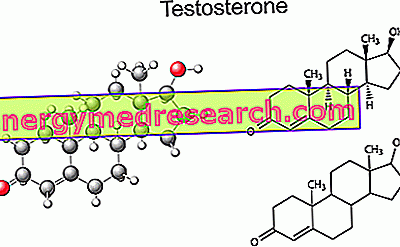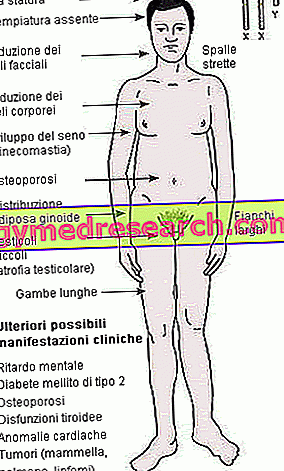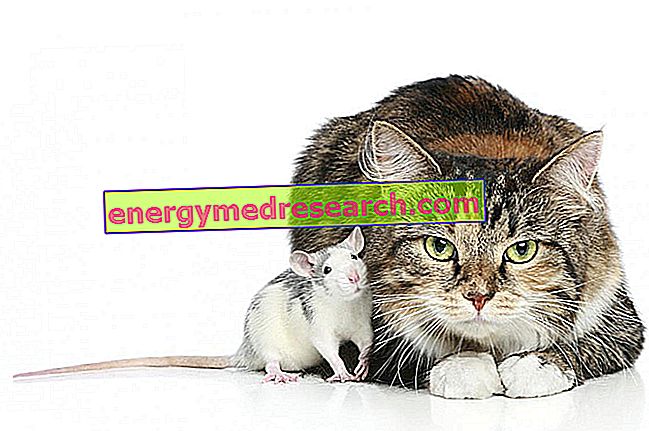Generality
Morris syndrome - also known as androgen insensitivity syndrome or testicular feminization - is a congenital condition that results from the impaired sensitivity of the cells of a male individual to androgens.

Androgens are the male sex hormones; their greatest exponent is testosterone.
Based on the level of insensitivity, doctors recognized the existence of a syndrome of partial androgen insensitivity and a syndrome of complete androgen insensitivity. In the first case, the patient can be a bearer of male and female genitals; in the second case, it presents the external genital apparatus of a woman, therefore it is considered a female person.
Unfortunately, there is no therapeutic remedy that restores the sensitivity of cells to androgens; the only treatments available today are symptomatic.
Short reference on sex chromosomes
In every cell, a healthy human being has 46 chromosomes (arranged in 23 pairs) in which the entire genetic material resides, better known as DNA .
Among these 46 chromosomes, there are two that have the task of determining the sex of a person and that, for this reason, are called sex chromosomes .
In women, the two sex chromosomes present are of the type X; in men, however, there is a sex chromosome of type X and a sex chromosome of the type Y.
The presence, in male individuals, of the sex chromosome Y is fundamental for the development of the testicles ( male gonads ) and to prevent, in the prenatal phase, the formation of the ovaries.
Just like the other 22 pairs of chromosomes, sexual chromosomes are also inherited from parents: one derives from the father and another from the mother.
What is Morris syndrome?
Morris syndrome - also known as androgen insensitivity syndrome or testicular feminization - is a pathological condition of varying severity, resulting from a partial or complete inability of male cells to respond to androgens (ie male sex hormones).
Since in man the androgens are responsible for the maturation of the primary and secondary sexual characters, this insensitivity leads to the missed (or incomplete) development of the external genitalia and of all those peculiar characteristics of a male subject.
It is important to specify that the aforementioned androgen insensitivity is already established during intrauterine life.
The most important androgen: testosterone
Testosterone is the androgen par excellence.
Produced by the so-called testicular cells of Leydig, under the direct influence of the luteinizing hormone ( LH ), it covers important functions. It is in fact the main responsible for the maturation and development of the external genitals, the appearance of secondary sexual characteristics (beard, mustache, hair, lowering of the tone of the voice, etc.), of the puberty growth, of spermatogenesis, of the development of libido, etc.
Although it is an androgen, testosterone is present, even in small quantities, even in women. Among the female individuals, its production is up to the ovaries (female gonads), but it is always influenced by the luteinizing hormone.
In both men and women, a contribution to testosterone synthesis also comes from the adrenal cortex.
TYPES OF MORRIS SYNDROME
Based on the level of response to androgens, doctors distinguish Morris syndrome in:
- Complete androgen insensitivity syndrome . In this case the body's cells are totally insensitive to androgens. This involves the absence, on the outside, of male sexual characteristics and the presence, always outside, of female sexual characteristics (vagina, female breast and somatic features typical of a woman).
Despite the presence of X and Y sex chromosomes, the carriers of the syndrome of complete androgen insensitivity are considered and bred as real women. Compared to the latter, however, they lack the uterus, ovaries and fallopian tubes, so they are not fertile.
- Partial androgen insensitivity syndrome . In this case the body's cells only partially respond to androgens. The degree of sensitivity varies from subject to subject and this affects the development of external sexual characteristics. For example, if the insensitivity is just mentioned (ie there is a good response to androgens), the external sexual characteristics will be strictly masculine (with some anomaly and a total absence of feminine characteristics); if, on the other hand, the insensitivity is of an intermediate degree, the affected individual may have external sexual characteristics both male and female.
Epidemiology
Androgen insensitivity syndrome is a very rare condition.
In fact, according to some statistical researches, the complete typology would be found in one newborn every 20, 000, while the partial typology in one newborn per 130, 000.
Causes
Morris syndrome arises following a mutation in the AR gene .
The AR gene is located in the sex chromosome X and produces a protein that performs the function of androgen receptor (NB: in English, AR stands for Androgen Recepetor ; in Italian, for Androgenic Receptor ).
ROLE OF THE ANDROGEN RECEPTOR
To interact with cells and initiate the development of male sexual characteristics, testosterone and other androgens need a link between them and the target cells. The connecting element is the protein deriving from the AR gene, called precisely the androgenic receptor.
In healthy male individuals, the androgenic receptor is present in adequate amounts and this allows testosterone to complete the development of sexual characteristics, both during fetal development and throughout life.
In contrast, in male individuals with Morris syndrome, the androgenic receptor is absent or present in small quantities and this abnormality causes testosterone, although present in adequate quantities, to be completely ineffective.
IS MUTATION CASUAL OR HEREDITARY?
Genetic studies have shown that the AR mutation can appear in a completely spontaneous way, shortly after conception, or it can be transmitted by the mother through inheritance .
According to some statistics, 1/3 of the cases of androgen insensitivity syndrome could be attributed to spontaneous mutations, which occurred shortly after conception, while the remaining 2/3 would be due to mutations transmitted by a mother with the altered AR gene.
Inheritance of Morris syndrome
The inherited form of Morris syndrome is an example of an inherited X-linked disease.
These pathologies have various implications, some of which deserve to be remembered:
- Generally, sick people are male. To understand why, readers should be reminded that men have only one X sex chromosome, while women have two. This means that, in humans, the consequences of a mutation against X are irretrievable, while, in women, they are counterbalanced by the presence of another healthy X.
- Women with a healthy X chromosome and a mutated X chromosome are called healthy carriers.
A healthy carrier, who joins a healthy man, has a 25% chance of giving birth to a sick male child. The remaining 75% is shared equally between: a healthy child, a healthy daughter and a healthy carrier daughter.
- The sick women derive from the union of a healthy woman carrier with a sick man. They are very rare situations, because often men with hereditary diseases linked to the X chromosome do not have the possibility to have children.
Symptoms and Complications
People with Morris syndrome are generally infertile men, so they cannot have children.
However, it is good to consider separately the type of complete insensitivity and that of partial insensitivity, since the symptomatological picture is not always superimposable.
CONSEQUENCES OF AN INSENSIBILITY? COMPLETE
In a male subject, complete androgen insensitivity determines:
- The development of female sexual characteristics only on the outside . The vagina can reach a length equal to 2/3 of that of a normal woman, while the breast increases in the years in which female puberty generally begins (between 8 and 14 years).
- Bilateral cryptorchidism (or retained testicle) . It consists in the failure to descend both testicles into the scrotum (NB: in subjects with a complete androgen insensitivity syndrome, the scrotum is not present). Often this problem leads to an inguinal hernia.
- Extremely reduced or limited presence of axillary and pubic hairs . These are generally formed during the years of puberty, thanks to the action of testosterone.
- Absence of acne . Acne is the result of a reaction to androgens, typical of puberty. The lack of acne is a clinical sign that, in the diagnostic field, has a certain relevance.
Moreover, it is worth remembering what has already been said about the anatomy of internal organs: people with Morris syndrome (regardless of the degree of insensitivity) lack the uterus, ovaries and fallopian tubes, as they are XY individuals.
CONSEQUENCES OF AN INSENSIBILITY? PARTIAL
The appearance of subjects with partial androgen insensitivity syndrome depends on how insensitive they are to male hormones.
If the insensitivity is moderate-severe, the patient can present:
- An almost complete vagina.
- A sketch of male genitals.
- A typically female breast, which develops during the years of puberty.
- One or both testicles retained, with the possibility of inguinal hernia
If, on the other hand, insensitivity is of a modest-mild degree, the carrier of Morris syndrome may have
- Normal male genitals (rare) or almost normal. Among the abnormalities of the genitals, the hypospadias is very frequent, that is the condition in which the opening of the urethra does not reside on the tip of the glans, but in a point along the ventral side of the penis.
- A sketch of vagina. It is however very rare.
- Alternating tendency to develop a female breast.
COMPLICATIONS
The complications of Morris syndrome include:
- Infertility . It concerns almost all the carriers of the condition. The cases of patients who manage to have children are a real rarity: generally they are individuals with an almost normal sensitivity to androgens.
- Depression and self-confidence . Becoming aware of belonging to an uncertain sex, neither totally masculine nor totally feminine, has usually serious repercussions on the mood and mood of the patients.
- Testicular cancer . The presence of cryptorchidism is very likely to affect its appearance.
Diagnosis
If the insensitivity to androgens is partial, doctors are able to identify Morris's syndrome shortly after birth, as the genitals have suspicious features (simultaneous presence of penis and vagina, etc.).
If, on the other hand, the insensitivity is complete, the post-partum diagnosis is quite unlikely, for the simple reason that the newborn has all the features of a child externally. In these situations, therefore, the identification (or at least the onset of a suspicion) usually occurs in the years of female puberty, since those processes typical of this phase of life do not occur: menstruation (need uterus, ovaries and fallopian tubes), growth of pubic and axillary hair and appearance of acne.
Inguinal hernia and prepubertal diagnosis
The appearance and subsequent surgical treatment of a serious inguinal hernia, which appeared in the first years of life, may be fundamental for a prepubertal diagnosis of the syndrome of complete androgen insensitivity.
In fact, the surgery involves an incision that brings to light the testicles retained and these presences, in a subject considered until then a child, are somewhat suspicious and worthy of further study.
BLOOD EXAMINATION AND ECOGRAPHY
To investigate the situation, doctors often resort to blood tests and an abdominal ultrasound .
Using blood tests, they measure testosterone levels. In subjects with Morris syndrome, the amounts of this androgen are normal; the problem, in fact, concerns other elements.
By means of an ultrasound scan, instead, it is possible to note the absence of the internal reproductive organs, ie uterus, ovaries and fallopian tubes.
DIAGNOSIS BEFORE THE BIRTH
Diagnosis before birth is quite rare, because it is rare for doctors to search for such an uncommon disease, such as Morris syndrome.
That said, they allow prenatal identification of the androgen insensitivity syndrome:
- The villocentesis, which consists in the collection and subsequent laboratory analysis of chorionic villi. It is generally performed between the 10th and 12th week of pregnancy.
- Amniocentesis, which consists in the collection and subsequent laboratory analysis of the amniotic fluid, that is of the fluid that surrounds and protects the fetus during its development.
It is usually performed between the 16th and 18th week of gestation.
Treatment
Premise: the genetic mutation that causes Morris syndrome is inherent in the genetic heritage and is impossible to correct. Thus, the insensitivity to androgens is a situation that cannot be remedied.
The first thing parents have to do, when they find out that their child suffers from Morris syndrome, is to go to a team of doctors who specialize in treating this disease.
In general, they are teams headed by a pediatric endocrinologist and made up of surgeons, other endocrinologists and psychologists.
The possible treatments are different and the choice of one, to the detriment of another, depends in part on the degree of insensitivity to androgens (for the complete typology there are treatments, for the partial typology there are others etc.) and partly from the will parents and patients.
The treatments generally provided include:
- Surgical interventions for the reconstruction / modification of male and female genitals (surgical therapy)
- Hormonal therapy
- Psychotherapy
SURGICAL THERAPY OF MALE GENITALS
Subjects with a complete androgen insensitivity syndrome will have to undergo surgical removal of the testicles, sooner or later.
This intervention - known as gonadectomy or orchiectomy - is indispensable, because criptorchidism is an important risk factor for testicular cancer.
At one time, doctors practiced gonadectomy as soon as they diagnosed the disease; today, instead, they await the end of puberty, because the presence of the testicles favors the conversion of androgens into estrogens, that is the hormones that in women promote the formation of female secondary sexual characteristics. Therefore, they postpone the intervention in order to avoid estrogen-based replacement therapy.
The treatment of cryptorchidism is also important for individuals with androgen partial insensitivity syndrome. In these situations, however, the planned operation is the so-called orchidopexy, which consists in placing the testicles retained in their natural anatomical site, ie the scrotum.
Also among patients partially sensitive to androgens, surgery for the resolution of hypospadias is also widespread.
SURGICAL THERAPY OF FEMALE GENITALS
If they accept their outward appearance as women, those with complete androgen insensitivity syndrome can undergo a vaginal canal lengthening surgery to improve the quality of their sexual life.
In general, surgeons only stretch on individuals who have passed puberty and are mature enough to decide for themselves what to do.
There are two possible surgical approaches: the dilation operation and vaginoplasty.
If they wish, even people with partial androgen insensitivity syndrome can undergo vaginal modification / improvement surgery. However, it is worth mentioning two fundamental aspects:
- Individuals with a very low sensitivity to androgens lend themselves to operations of this kind, therefore those who are outwardly more similar to a woman than to a man.
- The improvement of the vagina requires the removal of everything that resembles the male genitals and the retained testicles.
HORMONAL THERAPY
After the removal of the retained testicles, individuals with a complete androgen insensitivity syndrome must start estrogen-based hormone therapy . The purposes of this treatment are at least three:
- Prevent bone loss ( osteoporosis ), due to a lack of estrogen.
- Prevent the onset of menopausal symptoms . Speaking of menopause for XY individuals, who do not have ovaries, may seem strange (NB: the ovaries are the main sexual organs secreting estrogen). However, it is important to remember that menopause actually begins when a woman's body stops producing female sex hormones and that individuals with Morris syndrome are sensitive only to estrogen.
- Curb growth in height, induced by the sex chromosome Y. Subjects with Morris syndrome, who accept being women, may (for personal reasons) not like excessive height.
The planning of an estrogenic replacement therapy, in the presence of a partial insensitivity to androgens, depends on the patient's wishes: if he chooses to look like a woman outwardly, after the vaginal reconstruction and testicular removal, the aforementioned therapy results essential.
PSYCHOTHERAPY
Morris syndrome is a condition with which it is problematic to live together and which is difficult to accept, especially for those who find they are affected in the years of puberty.
The support of an expert psychotherapist can be of great help in preparing the patient to face, in the best way, the complications of Morris syndrome (first of all the fact of not being able to have children).
Obviously, not all carriers of Morris syndrome need to undergo psychotherapy. There are, in fact, cases that serenely live their own situation, without any moment of discouragement or distrust in themselves.
Prognosis
Remembering that there is no remedy for the mutation of the AR gene, the prognosis varies according to the type of androgen insensitivity:
- For cases of complete androgen insensitivity syndrome, the prognosis is good if the removal of the testicles retained took place at the appropriate time; delayed orchiectomy increases the risk of developing testicular cancer.
- For cases of Morris syndrome with partial insensitivity, the prognosis depends on the severity of the genital anomalies.



